Tokamak Edge Plasma Turbulence Interaction with Magnetic X-Point in 3D Global Simulations
Abstract
:1. Introduction
2. The TOKAM3X Code
3. Results
3.1. Deformation of Turbulent Structures Due to the X-Point
3.2. Fluctuations Amplitude in the Vicinity of the X-Point
3.3. Effects of a Transport Barrier on Edge Turbulence
3.4. The Role of Poloidal Shear in Suppressing Turbulence
4. Discussion: The Role of Reynolds Stress in Generating Poloidal Fluxes
5. Conclusions
Author Contributions
Funding
Acknowledgments
Conflicts of Interest
References
- Martin, Y.R.; Takizuka, T.; The ITPA CDBM H-mode Threshold Database Working Group. Power requirement for accessing the H-mode in ITER. J. Phys. Conf. Ser. 2008, 123, 012033. [Google Scholar] [CrossRef] [Green Version]
- Hubbard, A.E. Physics and scaling of the H-mode pedestal. Plasma Phys. Control. Fusion 2000, 42, A15–A35. [Google Scholar] [CrossRef] [Green Version]
- Burrell, K.H. Effects of ExB velocity shear and magnetic shear on turbulence and transport in magnetic confinement devices. Phys. Plasmas 1997, 4, 1499–1518. [Google Scholar] [CrossRef]
- Diamond, P.H.; Kim, Y.B. Theory of mean poloidal flow generation by turbulence. Phys. Fluids B 1991, 3, 1626. [Google Scholar] [CrossRef]
- Ricci, P.; Rogers, B.N.; Brunner, S. High and Low-Confinement Modes in Simple Magnetized Toroidal Plasmas. Phys. Rev. Lett. 2008, 100, 225002. [Google Scholar] [CrossRef] [PubMed]
- Garbet, X. Instabilités, turbulence et transport dans un plasma magnetisé 2001. Ph.D. Thesis, University of Marseille, Marseille, France, 2001. [Google Scholar]
- Waltz, R.E.; Staebler, G.M.; Dorland, W.; Hammett, G.W.; Kotschenreuther, M.; Konings, J.A. A gyro-Landau-fluid transport model. Phys. Plasmas 1997, 4, 2482. [Google Scholar] [CrossRef]
- Fedorczak, N.; Diamond, P.; Tynan, G.; Manz, P. Shear-induced Reynolds stress at the edge of L-mode tokamak plasmas. Nucl. Fusion 2012, 52, 103013. [Google Scholar] [CrossRef]
- Ghendrih, P.; Ciraolo, G.; Larmande, Y.; Sarazin, Y.; Tamain, P.; Beyer, P.; Chiavassa, G.; Darmet, G.; Garbet, X.; Grandgirard, V. Shearing effects on density burst propagation in SOL plasmas. J. Nucl. Mater. 2009, 390, 425–427. [Google Scholar] [CrossRef]
- Ciraolo, G.; Ghendrih, P.; Sarazin, Y.; Chandre, C.; Lima, R.; Vittot, M.; Pettini, M. Control of test particle transport in a turbulent electrostatic model of the Scrape-Off-Layer. J. Nucl. Mater. 2007, 363, 550–554. [Google Scholar] [CrossRef] [Green Version]
- Rasmussen, J.J.; Nielsen, A.H.; Madsen, J.; Naulin, V.; Xu, G.S. Numerical modeling of the transition from low to high confinement in magnetically confined plasma. Plasma Phys. Control. Fusion 2016, 58, 014031. [Google Scholar] [CrossRef]
- Halpern, F.; Ricci, P. Velocity shear, turbulent saturation, and steep plasma gradients in the scrape-off layer of inner-wall limited tokamaks. Nucl. Fusion 2017, 57, 034001. [Google Scholar] [CrossRef]
- Chang, C.S.; Ku, S.; Tynan, G.R.; Hager, R.; Churchill, R.M.; Cziegler, I.; Greenwald, M.; Hubbard, A.E.; Hughes, J.W. Fast Low-to-High Confinement Mode Bifurcation Dynamics in a Tokamak Edge Plasma Gyrokinetic Simulation. Phys. Rev. Lett. 2017, 118, 175001. [Google Scholar] [CrossRef] [PubMed]
- Wagner, F.; Becker, G.; Behringer, K.; Campbell, D.; Eberhagen, A.; Engelhardt, W.; Fussmann, G.; Gehre, O.; Gernhardt, J.; Gierke, G.V.; et al. Regime of Improved Confinement and High Beta in Neutral-Beam-Heated Divertor Discharges of the ASDEX Tokamak. Phys. Rev. Lett. 1982, 49, 1408–1412. [Google Scholar] [CrossRef]
- Moret, J.M.; Anton, M.; Barry, S.; Behn, R.; Besson, G.; Buhlmann, F.; Burri, A.; Chavan, R.; Corboz, M.; Deschenaux, C.; et al. Ohmic H-mode and confinement in TCV. Plasma Phys. Control. Fusion 1995, 37, A215. [Google Scholar] [CrossRef]
- The TOKAM3X code for edge turbulence fluid simulations of tokamak plasmas in versatile magnetic geometries. J. Comput. Phys. 2016, 321, 606–623. [CrossRef]
- Baudoin, C.; Tamain, P.; Bufferand, H.; Ciraolo, G.; Fedorczak, N.; Galassi, D.; Ghendrih, P.; Nace, N. Turbulent heat transport in TOKAM3X edge plasma simulations. Contrib. Plasma Phys. 2018, 58, 484–489. [Google Scholar] [CrossRef]
- Galassi, D.; Tamain, P.; Bufferand, H.; Ciraolo, G.; Ghendrih, P.; Baudoin, C.; Colin, C.; Fedorczak, N.; Nace, N.; Serre, E. Drive of parallel flows by turbulence and large-scale E × B transverse transport in divertor geometry. Nucl. Fusion 2017, 57, 036029. [Google Scholar] [CrossRef]
- Braginskii, S.I. Transport Processes in a Plasma; Provided by the SAO/NASA Astrophysics Data System; Consultants Bureau: New York, NY, USA, 1965; Volume 1, p. 205. [Google Scholar]
- Hinton, F.L.; Horton, C.W. Amplitude Limitation of a Collisional Drift Wave Instability. Phys. Fluids 1971, 14, 116. [Google Scholar] [CrossRef]
- Dimitrova, M.; Dejarnac, R.; Popov, T.K.; Ivanova, P.; Vasileva, E.; Kovačič, J.; Stöckel, J.; Havlicek, J.; Janky, F.; Panek, R. Plasma Parameters in the COMPASS Divertor During Ohmic Plasmas. Contrib. Plasma Phys. 2014, 54, 255–260. [Google Scholar] [CrossRef]
- Stangeby, P.C. The Plasma Boundary of Magnetic Fusion Devices; Institute of Physics Publishing: Bristol, UK, 2000. [Google Scholar]
- Farina, D.; Pozzoli, R.; Ryutov, D. Effect of the magnetic field geometry on the flute-like perturbations near the divertor X point. Nucl. Fusion 1993, 33, 1315. [Google Scholar] [CrossRef]
- Walkden, N.R.; Dudson, B.D.; Fishpool, G. Characterization of 3D filament dynamics in a MAST SOL flux tube geometry. Plasma Phys. Control. Fusion 2013, 55, 105005. [Google Scholar] [CrossRef] [Green Version]
- Galassi, D.; Tamain, P.; Baudoin, C.; Bufferand, H.; Ciraolo, G.; Fedorczak, N.; Ghendrih, P.; Nace, N.; Serre, E. Characterization of tokamak edge plasma turbulence in 3D global simulations with divertor geometry. In Proceedings of the 44th EPS Conference, Belfast, UK, 26–30 June 2017. [Google Scholar]
- Walkden, N.; Harrison, J.; Silburn, S.; Farley, T.; Henderson, S.; Kirk, A.; Militello, F.; Thornton, A.; The MAST Team. Quiescence near the X-point of MAST measured by high speed visible imaging. Nucl. Fusion 2017, 57, 126028. [Google Scholar] [CrossRef] [Green Version]
- Wersal, C.; Ricci, P. Impact of neutral density fluctuations on gas puff imaging diagnostics. Nucl. Fusion 2017, 57, 116018. [Google Scholar] [CrossRef] [Green Version]
- Walkden, N.; Militello, F.; Harrison, J.; Farley, T.; Silburn, S.; Young, J. Identification of intermittent transport in the scrape-off layer of MAST through high speed imaging. Nucl. Mater. Energy 2017, 12, 175–180. [Google Scholar] [CrossRef] [Green Version]
- Walkden, N.R.; Labit, B.; Reimerdes, H.; Harrison, J.; Farley, T.; Innocente, P.; Militello, F.; The TCV Team; The MST1 Team. Fluctuation characteristics of the TCV snowflake divertor measured with high speed visible imaging. Plasma Phys. Control. Fusion 2018, 60, 115008. [Google Scholar] [CrossRef]
- Wesson, J. Tokamaks; Oxford University Press: Oxford, UK, 2004. [Google Scholar]
- Xanthopoulos, P.; Mikkelsen, D.; Jenko, F.; Dorland, W.; Kalentev, O. Verification and application of numerically generated magnetic coordinate systems in gyrokinetics. Phys. Plasmas 2008, 15, 122108. [Google Scholar] [CrossRef] [Green Version]
- Lewandowski, J.L.V.; Persson, M. Local magnetic shear in tokamak plasmas. Plasma Phys. Control. Fusion 1995, 37, 1199. [Google Scholar] [CrossRef]
- Nadeem, M.; Rafiq, T.; Persson, M. Local magnetic shear and drift waves in stellarators. Phys. Plasmas 2001, 8, 4375–4385. [Google Scholar] [CrossRef]
- Gallo, A.; Fedorczak, N.; Elmore, S.; Maurizio, R.; Reimerdes, H.; Theiler, C.; Tsui, C.K.; Boedo, J.A.; Faitsch, M.; Bufferand, H.; et al. Impact of the plasma geometry on divertor power exhaust: Experimental evidence from TCV and simulations with SolEdge2D and TOKAM3X. Plasma Phys. Control. Fusion 2018, 60, 014007. [Google Scholar] [CrossRef]
- Nace, N.; Tamain, P.; Baudoin, C.; Bufferand, H.; Ciraolo, G.; Fedorczak, N.; Galassi, D.; Ghendrih, P.; Serre, E. Impact of safety factor and magnetic shear profiles on edge turbulence in circular limited geometry. Contrib. Plasma Phys. 2018, 58, 497–504. [Google Scholar] [CrossRef]
- Tamain, P.; Bufferand, H.; Ciraolo, G.; Colin, C.; Serre, E.; Schwander, F. 3D Properties of Edge Turbulent Transport in Full-Torus Simulations and their Impact on Poloidal Asymmetries. Contrib. Plasma Phys. 2014, 559, 555–559. [Google Scholar] [CrossRef]
- Floriani, E.; Ciraolo, G.; Ghendrih, P.; Lima, R.; Sarazin, Y. Self-regulation of turbulence bursts and transport barriers. Plasma Phys. Control. Fusion 2013, 55, 095012. [Google Scholar] [CrossRef] [Green Version]
- Nace, N.; Perin, M.; Tamain, P.; Ciraolo, G.; Baudoin, C.; Futtersack, R.; Ghendrih, P.; Norscini, C. Turbulence Interaction with Driven Transport Barriers in the Scrape-Off Layer of Tokamaks. Contrib. Plasma Phys. 2016, 56, 581–586. [Google Scholar] [CrossRef]
- Ghendrih, P.; Sarazin, Y.; Ciraolo, G.; Darmet, G.; Garbet, X.; Grangirard, V.; Tamain, P.; Benkadda, S.; Beyer, P. Transport barrier fluctuations governed by SOL turbulence spreading. J. Nucl. Mater. 2007, 363, 581–585. [Google Scholar] [CrossRef]
- Galassi, D.; Tamain, P.; Baudoin, C.; Bufferand, H.; Ciraolo, G.; Fedorczak, N.; Ghendrih, P.; Nace, N.; Serre, E. Flux expansion effect on turbulent transport in 3D global simulations. Nucl. Mater. Energy 2017. [Google Scholar] [CrossRef]
- Cartier-Michaud, T.; Ghendrih, P.; Sarazin, Y.; Abiteboul, J.; Bufferand, H.; Dif-Pradalier, G.; Garbet, X.; Grandgirard, V.; Latu, G.; Norscini, C.; et al. Projection on Proper elements for code control: Verification, numerical convergence, and reduced models. Application to plasma turbulence simulations. Phys. Plasmas 2016, 23, 020702. [Google Scholar] [CrossRef] [Green Version]
- Tamaina, P.; Baudoinab, C.; Bufferanda, H.; Ciraoloa, G.; Fanc, D.-M.; Fedorczaka, N.; Galassib, D.; Ghendriha, P.; Luceab, B.; Marandetc, Y.; et al. Impact of self-consistent neutrals dynamics and particle sources on edge plasma transport and turbulence in 3D first principle simulations. In Proceedings of the 23rd International Conference on Plasma Surface Interactions in Controlled Fusion Devices, Princeton, NJ, USA, 18–22 June 2018. [Google Scholar]
- Paruta, P.; Ricci, P.; Riva, F.; Wersal, C.; Beadle, C.; Frei, B. Simulation of plasma turbulence in the periphery of diverted tokamak by using the GBS code. Phys. Plasmas 2018, 25, 112301. [Google Scholar] [CrossRef]
- Stegmeir, A.; Coster, D.; Ross, A.; Maj, O.; Lackner, K.; Poli, E. GRILLIX: A 3D turbulence code based on the flux-coordinate independent approach. Plasma Phys. Control. Fusion 2018, 60, 035005. [Google Scholar] [CrossRef]
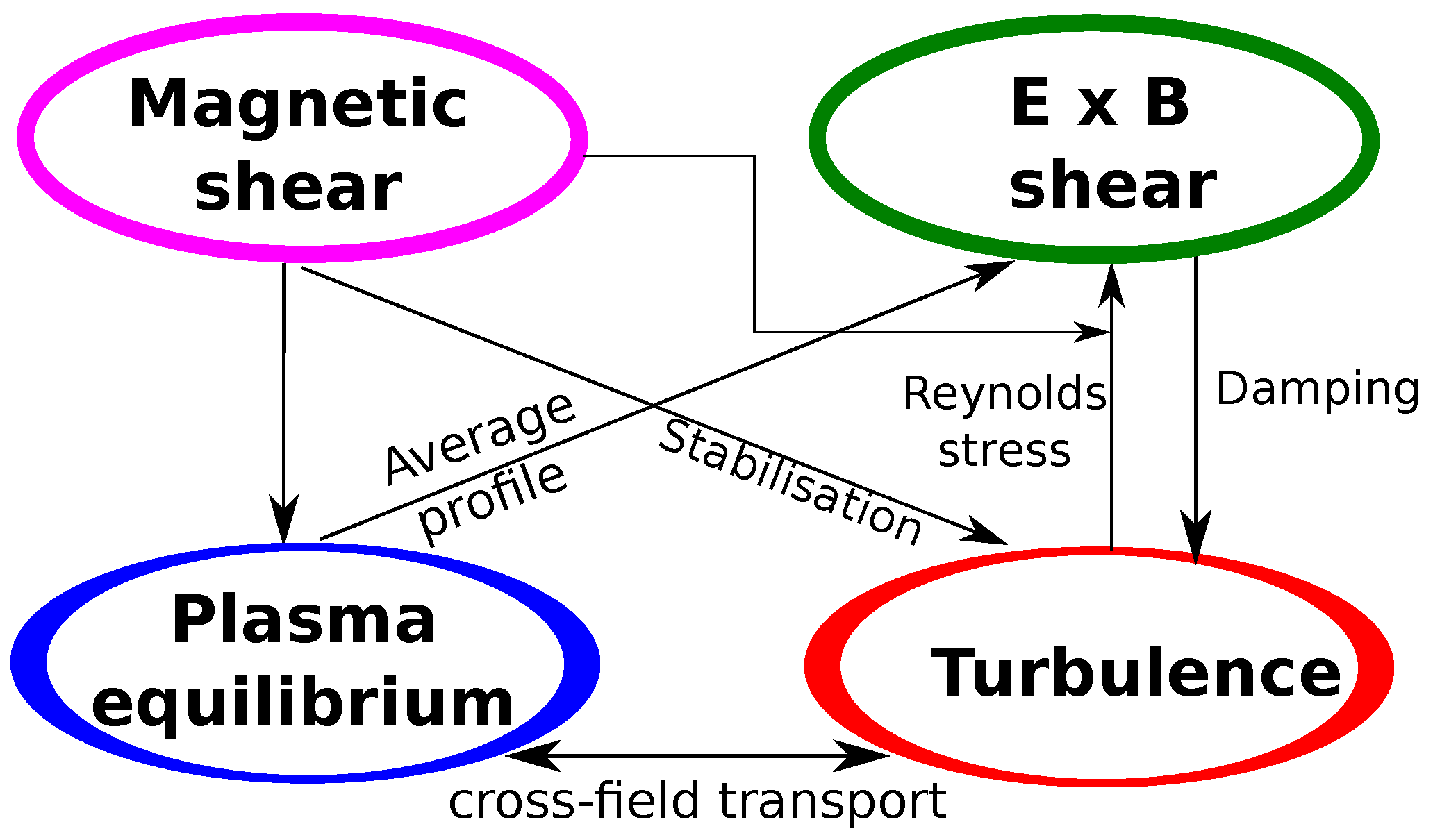
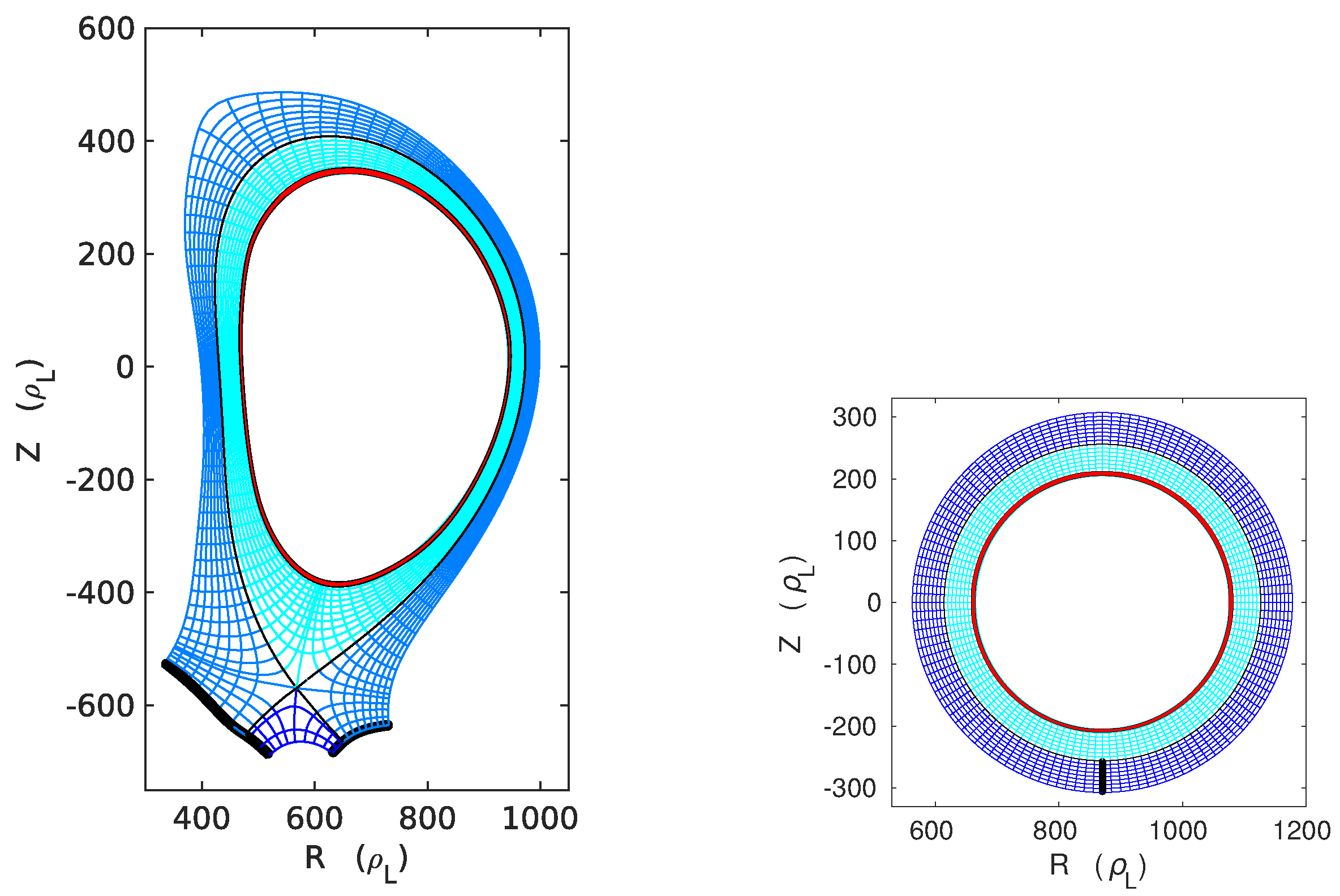
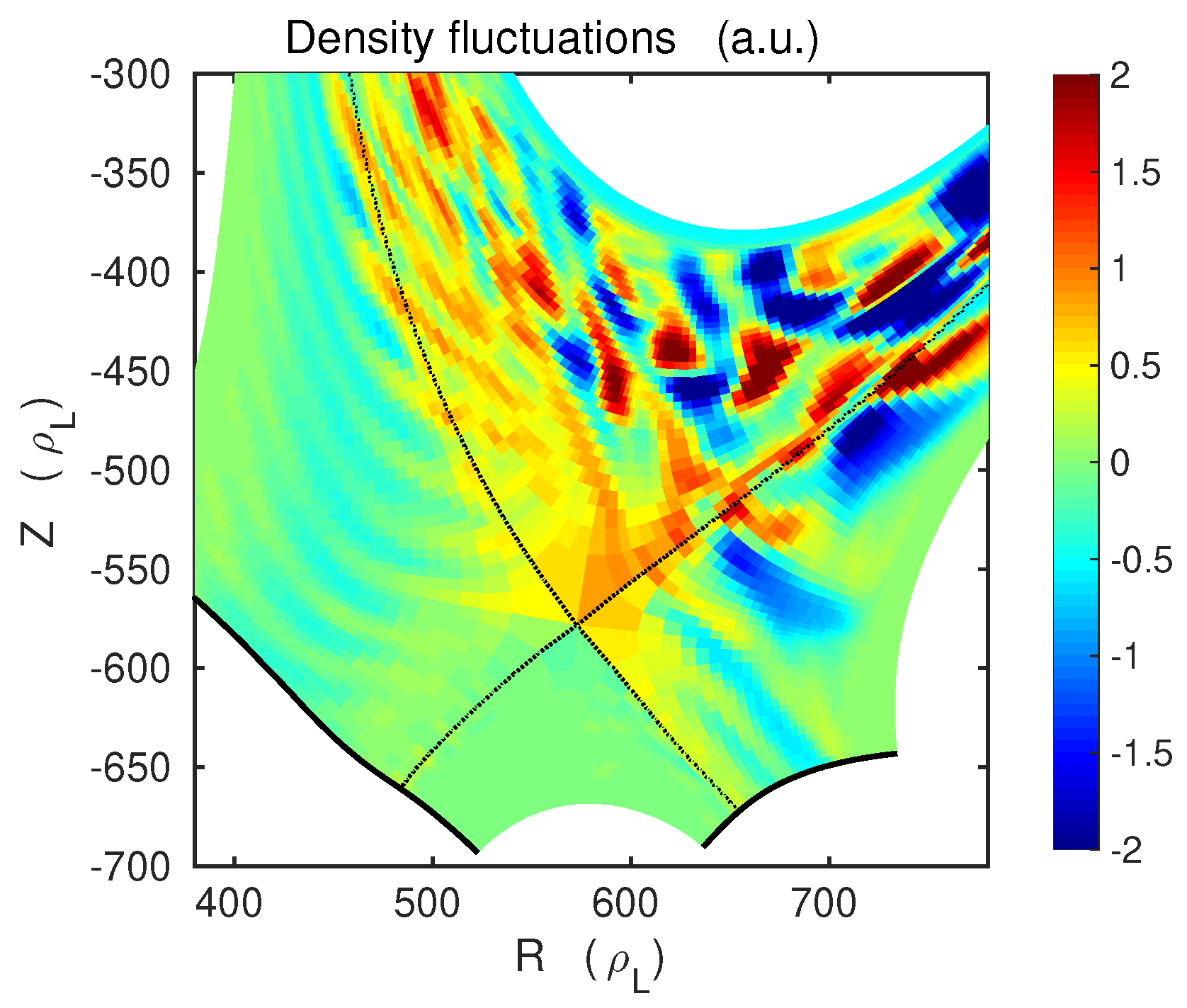

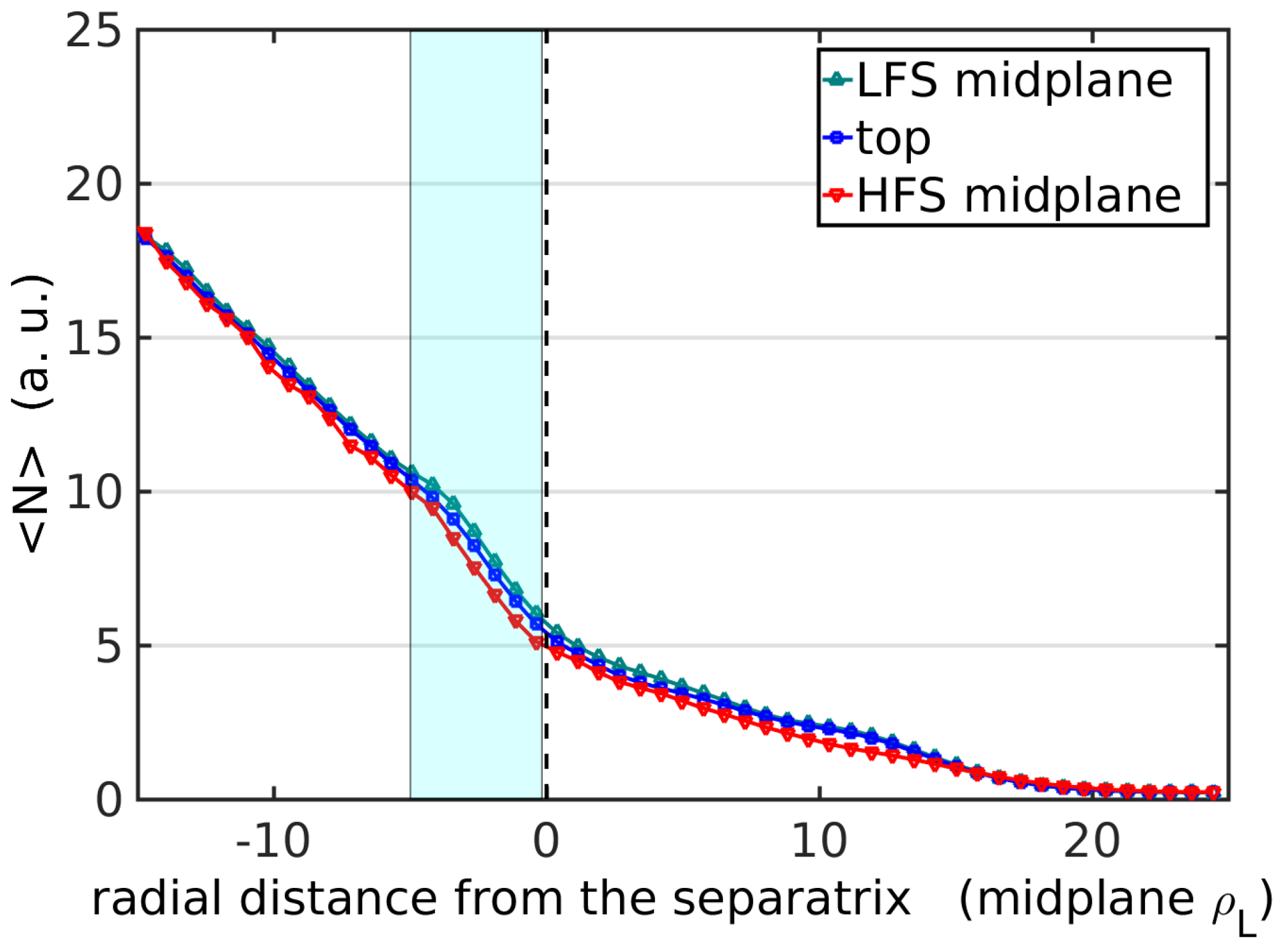
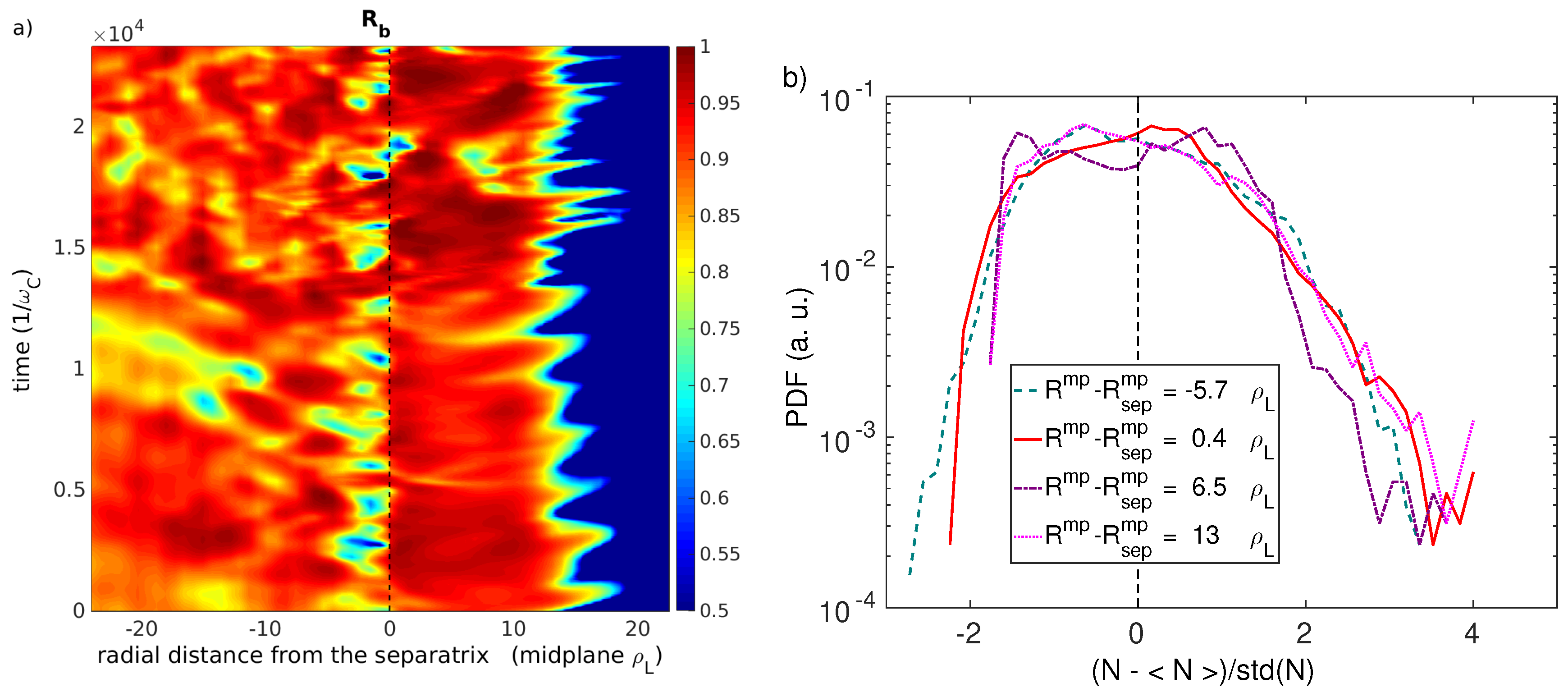
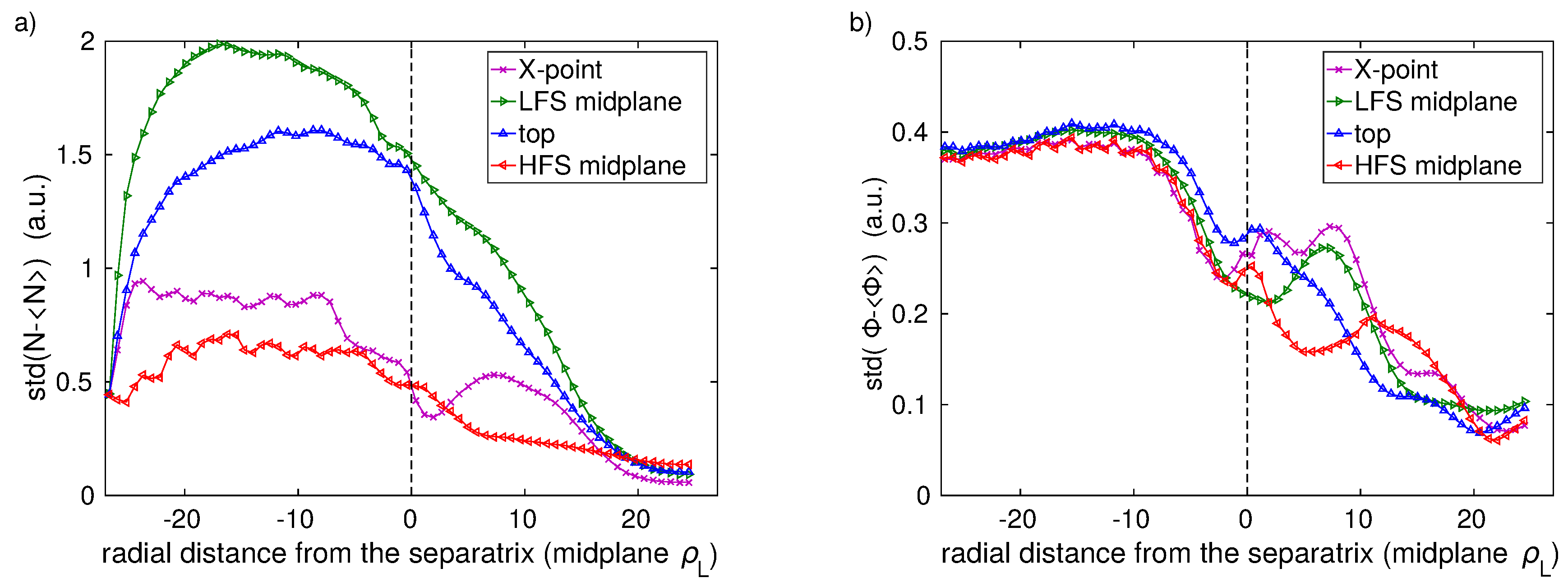
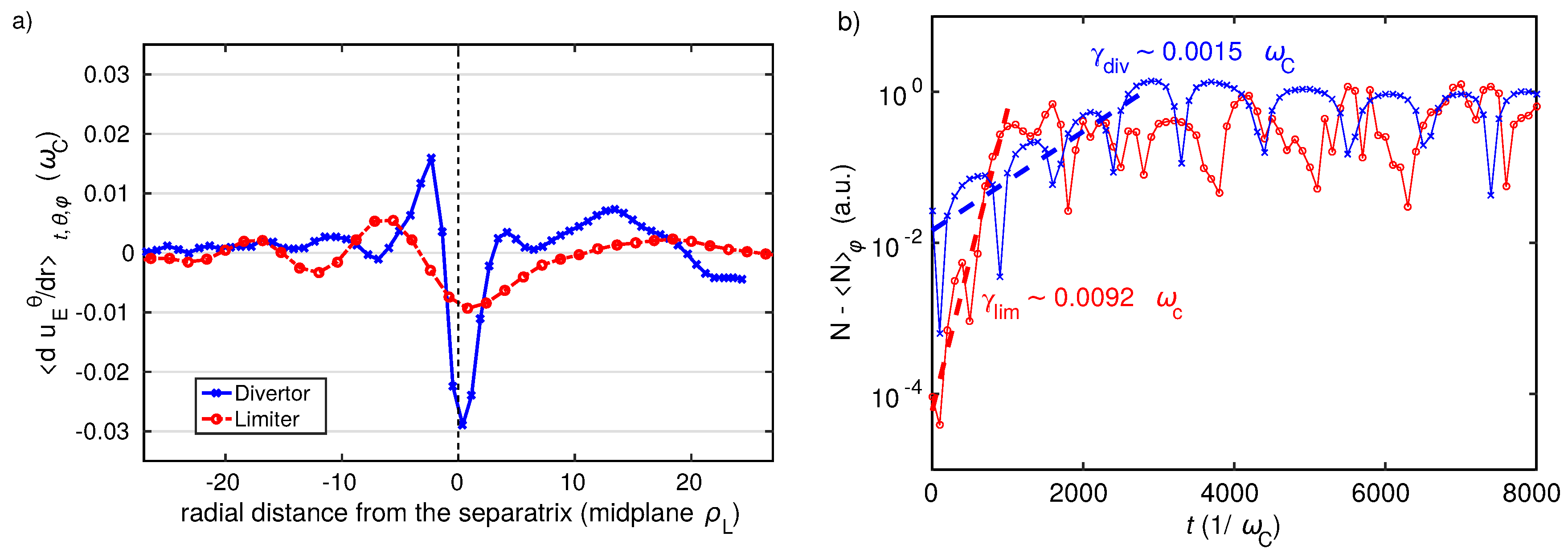
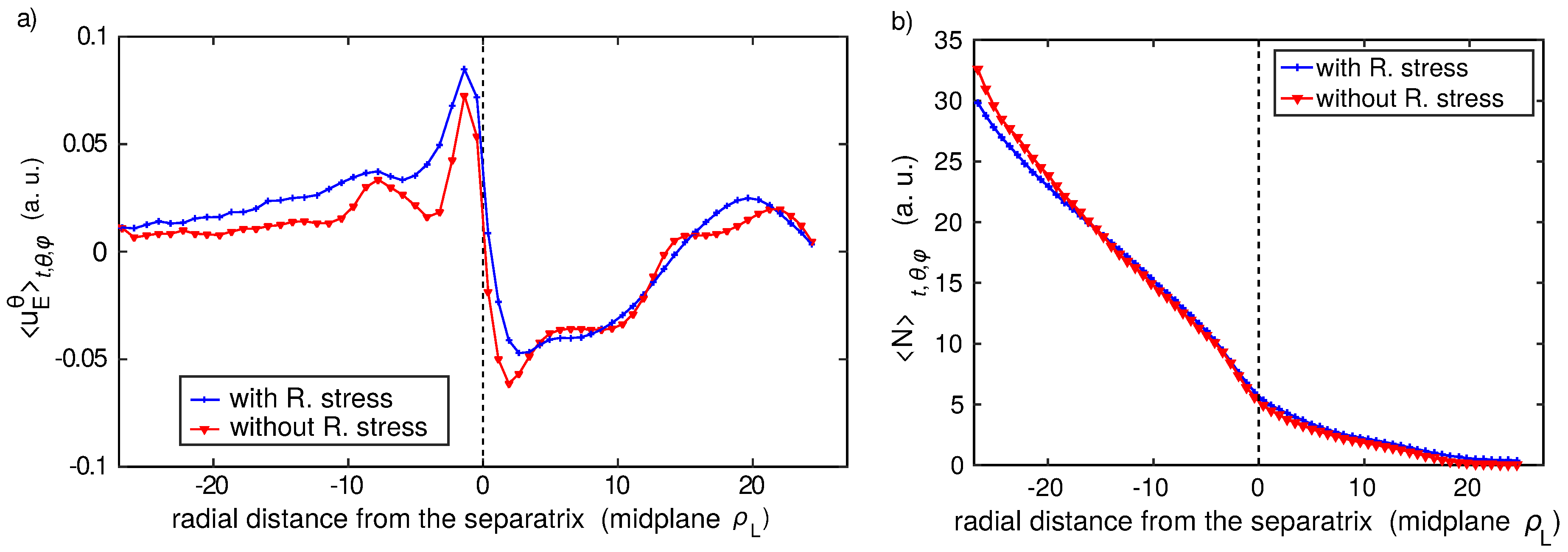
© 2019 by the authors. Licensee MDPI, Basel, Switzerland. This article is an open access article distributed under the terms and conditions of the Creative Commons Attribution (CC BY) license (http://creativecommons.org/licenses/by/4.0/).
Share and Cite
Galassi, D.; Ciraolo, G.; Tamain, P.; Bufferand, H.; Ghendrih, P.; Nace, N.; Serre, E. Tokamak Edge Plasma Turbulence Interaction with Magnetic X-Point in 3D Global Simulations. Fluids 2019, 4, 50. https://doi.org/10.3390/fluids4010050
Galassi D, Ciraolo G, Tamain P, Bufferand H, Ghendrih P, Nace N, Serre E. Tokamak Edge Plasma Turbulence Interaction with Magnetic X-Point in 3D Global Simulations. Fluids. 2019; 4(1):50. https://doi.org/10.3390/fluids4010050
Chicago/Turabian StyleGalassi, Davide, Guido Ciraolo, Patrick Tamain, Hugo Bufferand, Philippe Ghendrih, Nicolas Nace, and Eric Serre. 2019. "Tokamak Edge Plasma Turbulence Interaction with Magnetic X-Point in 3D Global Simulations" Fluids 4, no. 1: 50. https://doi.org/10.3390/fluids4010050
APA StyleGalassi, D., Ciraolo, G., Tamain, P., Bufferand, H., Ghendrih, P., Nace, N., & Serre, E. (2019). Tokamak Edge Plasma Turbulence Interaction with Magnetic X-Point in 3D Global Simulations. Fluids, 4(1), 50. https://doi.org/10.3390/fluids4010050




